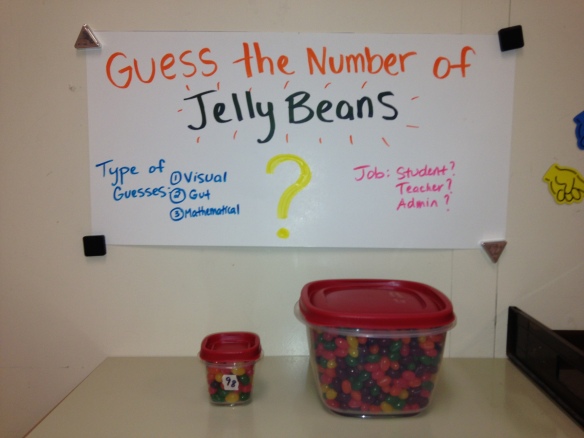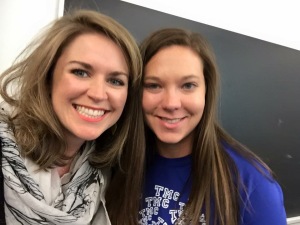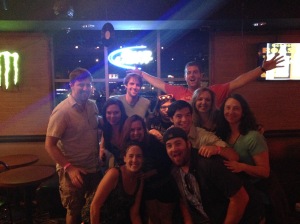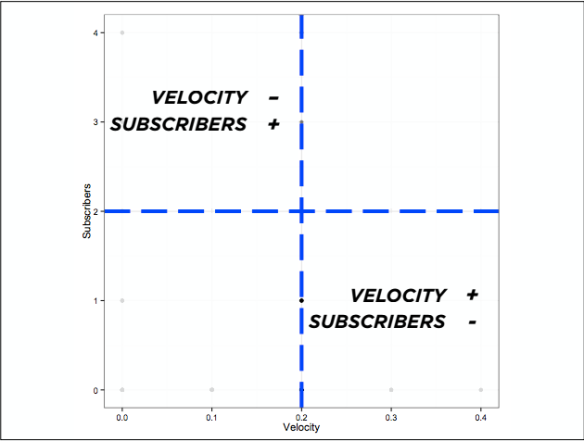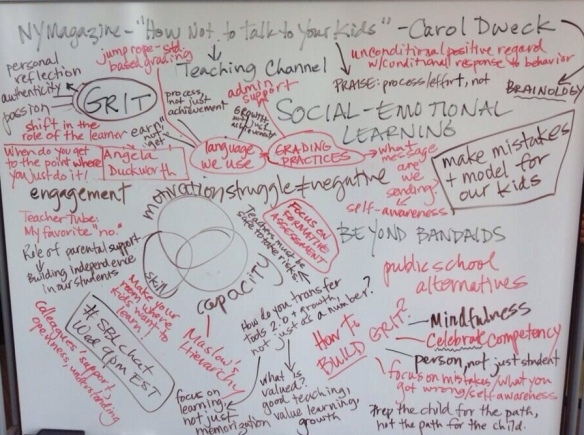After attending Twitter Math Camp 2014 in Jenks, OK, I immediately flew to Hilton Head where I joined my family on vacation. While lounging by the pool, I had a lot of time to reflect on this year’s camp. It still ranks as the best professional development experience I have ever had, but I often struggle to find ways to articulate why TMC is so special. Prior to attending, whenever I told someone I was going to a Twitter Math Camp, the person laughed and made a joke about nerdy math teachers.
So I changed my story: “Me: I’m going to a math conference. Them: Oh cool, hope you learn a lot.” And I hated myself for those interactions. Why does everyone else think a math conference is acceptable to attend, even cool, when I (and I’m sure most TMC attendees would agree) that Twitter Math Camp is by far the coolest “conference” a math teacher will ever attend? But it’s because they don’t understand. I know that I shouldn’t take the easy way out by changing my story, and I’ve promised myself to never do that again. I want to help people (especially math teachers!) understand and appreciate what everyone in the MathTwitterBlogosphere (MTBoS) has created together. The comparison to an actual overnight summer camp might actually help the most. At TMC, you attend sessions of interest to you, listen to inspiring speakers, eat every single meal with your fellow campers, play games (some math some not) during free time, explore your surroundings, and stay up way past your bedtime. After four days, you are exhausted; you are inspired; you are passionate; you are reflecting; you are questioning; you are bonded. Luckily, the conversations that begin at TMC don’t have to end at TMC. Throughout the year, we will continue chatting on twitter, blog posts, text messages; so if you’re out there lurking, jump in and join the conversation, then join us at Harvey Mudd College next summer.
In the same spirit as last year, I will recap some of TMC as a series of “My Favorites” (in no particular order).
Favorite Airport Reading: Powerful Problem Solving by Max Ray. I wanted to read this book last summer but never got around to it. I’m now four chapters in and devouring it. Max writes about problem solving strategies directly connected with the standards for mathematical practice. He shares numerous activities you can do with your students tomorrow and shares actual samples of student work/classroom conversations.

Favorite Standard for Mathematical Practice: In Steve Leinwand’s keynote, Shifting Our Mindsets and Our Actions from Remembering HOW to Understanding WHY, he referred to SMP #3 as the “Trojan Horse” and the “Most important 9 words in the CCSS.” I would have to agree with Steve on this one. SMP #3 = Construct viable arguments and critique the reasoning of others. Students must be able to communicate their findings and respond to the conclusions of others. This is a practice that must be taught explicitly and will be one of my goals for this school year. I plan on echoing Steve, and demanding that students “CONVINCE ME” of their conclusions.
Favorite Game: Andy Pethan introduced me to the game, Q-bitz, during Wednesday’s game night. There are three different challenges where you have to recreate patterns out of cubes faster than your competitors. As someone who loves math and wants to be on Survivor one day, this game is right up my ally.

Source: Amazon
Favorite Opening Day Activity: John Mahlstedt tells his students how awesome he is on the first day of school by sharing facts/pictures about himself. It’s a way for students to learn that you’re not only a teacher, but a human too, and a fun one. I usually have students try the matching activity below, but normally I simply share the answers at the end of class. This year, I’m going to enhance this activity with John’s suggestion of making a slideshow with pictures to show my students rather than just telling them about me.
Favorite Lunchtime Adventure: During lunch one day, a group of us found Gameday Popcorn on main street and had a great time testing all the flavors.

Favorite Morning Session: Writing Real World Lessons with Mathalicious. Karim and Matt led a fantastic session on the creation process of Mathalicious lessons: “The narrative determines the standards, not vice-versa.” This was so interesting to me because I feel that most of the time, when my colleagues and I are discussing an upcoming topic/unit, we are doing the vice-versa. Ex. Tomorrow we have to teach solving systems of equations by elimination… how should we do this? Mathalicious lessons are conversations about a really interesting topic that needs math to answer the question. That’s why the lessons are so authentic and engaging. Our group spent time proposing thought-provoking questions, discussing their authenticity, and attempting to write a sample lesson out of our ideas. The experience was extremely rewarding and although it’s time consuming, I hope to bring this practice back to my own planning time.
Favorite Cupcake Locale: Smallcakes. Delicious.

Favorite Formative Assessment Explanation: John Scammell shared more than 60 formative assessment strategies that you can easily implement in your classroom. He kindly shared all of them here, but it’s how he described formative assessment that actually stuck with me the most. John said that formative assessment must be risk free. If you put a grade on it, or enter it into an online grading system, it’s no longer risk free to a student or parent. Formative assessment should be all about providing feedback. One easy suggestion is to use a highlighter to mark the last spot a student’s work was right. Another is to mark a problem with a + (better than previous work), – (worse than previous work), or = (equal to previous work) sign. And my favorite method he shared, was to actually classify a student’s error. Many students get frustrated when something is marked wrong, and they immediately think they don’t understand anything. It’s important to differentiate between whether an error is a conceptual misunderstanding or calculation mistake.
Favorite Ice Breaker: Bob Lochel discussed Meaningful Adjacencies as related to the 9/11 Memorial in NY and how a similar connection activity with tv shows can be used in your classroom. He provides a very thorough explanation on his blog post.
Favorite Phone Holder: Glenn Waddell taught us an ingenious way to use a smartphone as a video camera in your classroom. 1) Make a vertical slit in the bottom of a paper coffee cup 2) Insert smartphone 3) Record

Favorite Dan Meyer Quote: “I want to profit off what you know.” – Dan Meyer
In Dan’s keynote address, he shared tons of data on tweeting and blogging math teachers. He’s interested because he knows that great ideas are being shared, but no one knows about them. He wants to know about them. And so do I. When you post/tweet your great ideas, my students get to benefit from them. It’s okay to be selfish here, because the more students that benefit, the better it is.
Favorite Dan Meyer Slide: Dan shared a graph comparing a blogger’s velocity (posts per week) to number of subscribers. He said he’s interested in the individuals in quadrant 2, those who post infrequently, but have many readers. After examining his data, it appears that my blog falls in quadrant 2. I post infrequently because I’m afraid and therefore selective. Afraid that what I’m offering won’t be as good as what other people are offering. So I’m choosy. I like to post activities after I’ve done them so I know if they worked or not, and so I can edit them before posting. I try to include any part of the activity that is downloadable, so you can take it and use it tomorrow. I post when I want more than the 100 students on my roster to benefit from something fun. Maybe this is why some of you are following my blog, if you have other insights, please let me know. But in the meantime, thank you for reading!
Favorite Desmos Update: In his keynote, Eli Luberoff assured us that Desmos would be free forever. This is incredible news. Desmos has created API partnerships and has financial security to ensure that we will never have to pay to use this online graphing calculator. All teachers and students can benefit from this resource, so if you haven’t played with it yet, stop reading and go to Desmos now. Also, be sure to check out this new digital math lesson from Dan Meyer, Christopher Danielson, and Desmos: Central Park (and the other four lessons on Teacher Desmos).
Favorite Roommate: Rachel and I bonded over being teachers at the high schools we went to, Algebra 1, True Detective, Richard Linklater films, quiet time, beer choices, traveling and so much more. Check out her blog here and let’s convince her to post more this year.

Favorite App: Pam Wilson introduced TMC to Plickers and our classrooms will never be the same. Each student responds to a multiple choice question by holding up a unique bar code. The teacher uses a smartphone to scan the room and the responses are graphed/recorded automatically. I see myself using this as a quick formative assessment at the end of class.

Source: @approx_normal
Favorite BBQ: Elmer’s with this fun crew. Thank you Jason for treating us!

Favorite 3D Printing Resources: John Stevens and I talked about using 3D printers in the math classroom. We are going to have several 3D printers at my school next year and I want to do something awesome with them. If you have any advice, please share with John and me!
Favorite Book Recommendation – Justin Lanier plugged the books How Children Learn and How Children Fail by John Holt. Justin’s takeaways: 1) Look Around 2) Teach Crazy 3) Trust Children.
I know there’s a lot of TMC awesome-ness that has been left out of this post, but I could never write about everything that I learned, because it would take forever. I owe a huge shout-out to all the TMC14 organizers for making this happen and providing us with this incredible experience. Thank you to everyone I met, and I hope to see you all again next year 🙂
 It’s no surprise that I’m completely obsessed with Desmos and want to share it with teachers everywhere. This past year, I was given a few opportunities to run Desmos professional development for the teachers in my district, and in a few surrounding Massachusetts towns. Several people have asked me for my PD plan, so here it is:
It’s no surprise that I’m completely obsessed with Desmos and want to share it with teachers everywhere. This past year, I was given a few opportunities to run Desmos professional development for the teachers in my district, and in a few surrounding Massachusetts towns. Several people have asked me for my PD plan, so here it is: 
